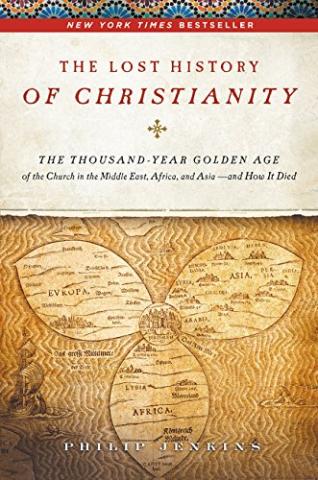The Lost History of Christianity: The Thousand-Year Golden Age of the Church in the Middle East, Africa, and Asia—and How It Died

Synopsis
Church history as taught in the west revolves around the Orthodox, Roman Catholic, and Protestant branches of Christianity. However, that is only a part of the story. The Christian church to the east was at least as large and influential if not more so than the church in the west; now it is nearly non-existent. Jenkins tells the story of the rise and fall of the eastern church, how it reached all the way into China and Japan, as well as into Central Asia and India, then analyzes its effects on world history and what caused its fall, as well as raising provocative questions that the Church should consider as the twenty-first century advances.
Evaluation
Jenkins’ book is one of the best history works that I’ve read in a while. It is well-written, engaging, encouraging, disheartening, challenging, and thought-provoking. Jenkins takes a rather broader view of Christianity than western (and especially Gospel- and bibliocentric) Christians would accept, viewing the eastern Monophysites as orthodox (in the literal sense) in their faith. The eastern Church’s commitment to spreading the Good News about Jesus Christ eastward and their success in it until the 13th century, while the western Orthodox (in the denominational sense) and Roman Catholic churches turned inward, would suggest that God used them mightily for his purposes, making us shout for joy, for the numbers of worshippers from every tongue, tribe and nation (Rev. 7:9) will be even greater than we can imagine. The fall of those churches should cause us to lament and weep before the Lord, for a great witness has been lost to the ages.
I believe Jenkins’ book should be read by every true Christian, as it, like the Old Testament, shows the things that happened to the eastern Church “as examples, and they were written as a warning to us, on whom the ends of the ages have come” (1Co. 10:1 – HCSB). Especially the analysis of the factors contributing to the collapse of the eastern Church in chapter 8 as well as the difficult questions in chapter 9 need to be considered by the Church as she plants new cells and copes with changes in the society around her. After nearly 1000 years of ascendancy and tolerance, the pressures falling on the European and North American wings of the Church in particular sound much like the twilight years of the eastern Church. It’s time to learn from the past and not repeat the mistakes of our eastern brothers and sisters. Jenkins’ book also encourages us to ask the hard questions about why the fellowships of our eastern brothers and sisters were allowed to be destroyed. It encourages us to question our comfortable eschatology and pushes us to remember the urgency we should have in bringing the Good News about Jesus to everyone, even and especially those who are intolerant of and antagonistic towards us.
Review is Copyright © 2017 J.M. Diener. All Rights Reserved.